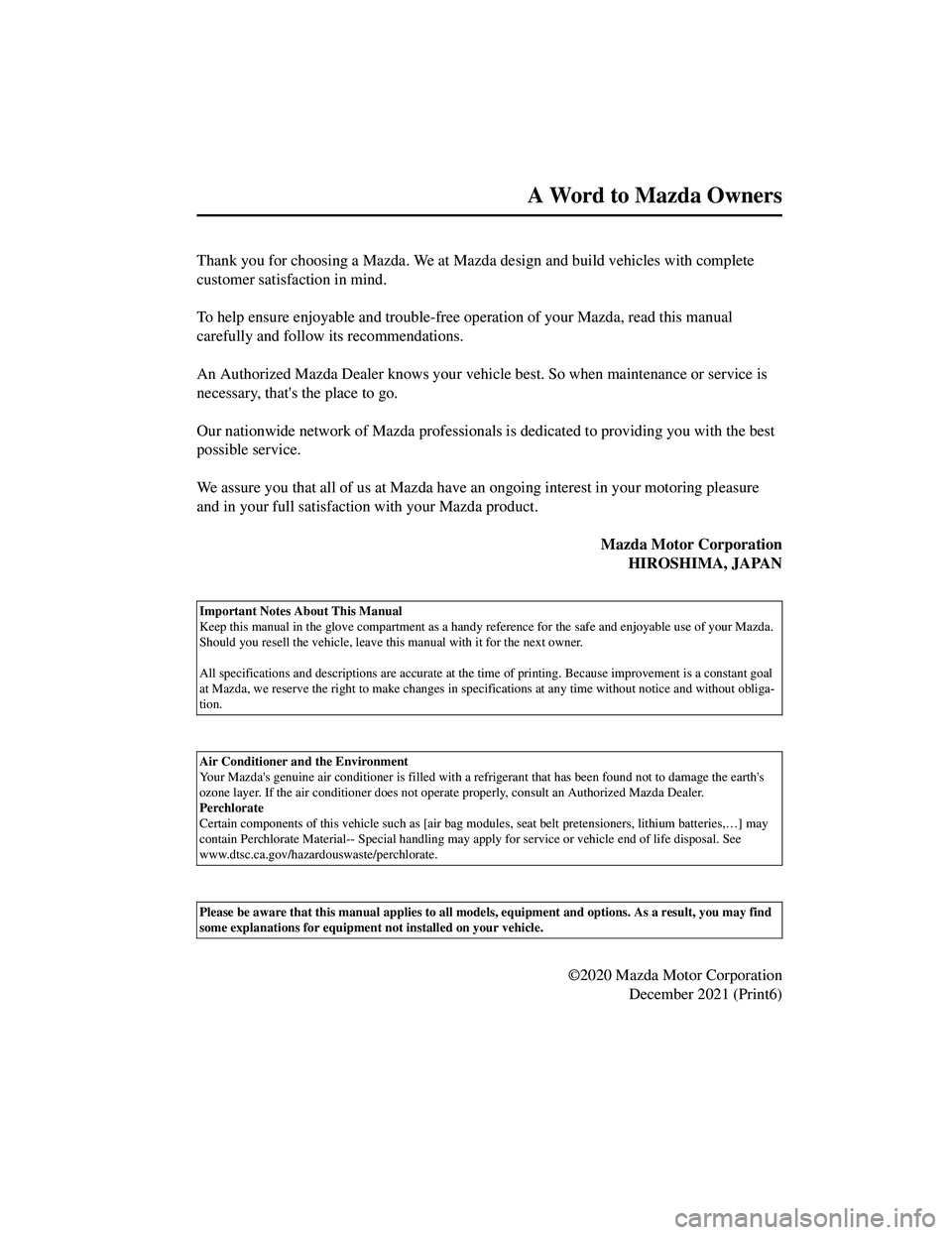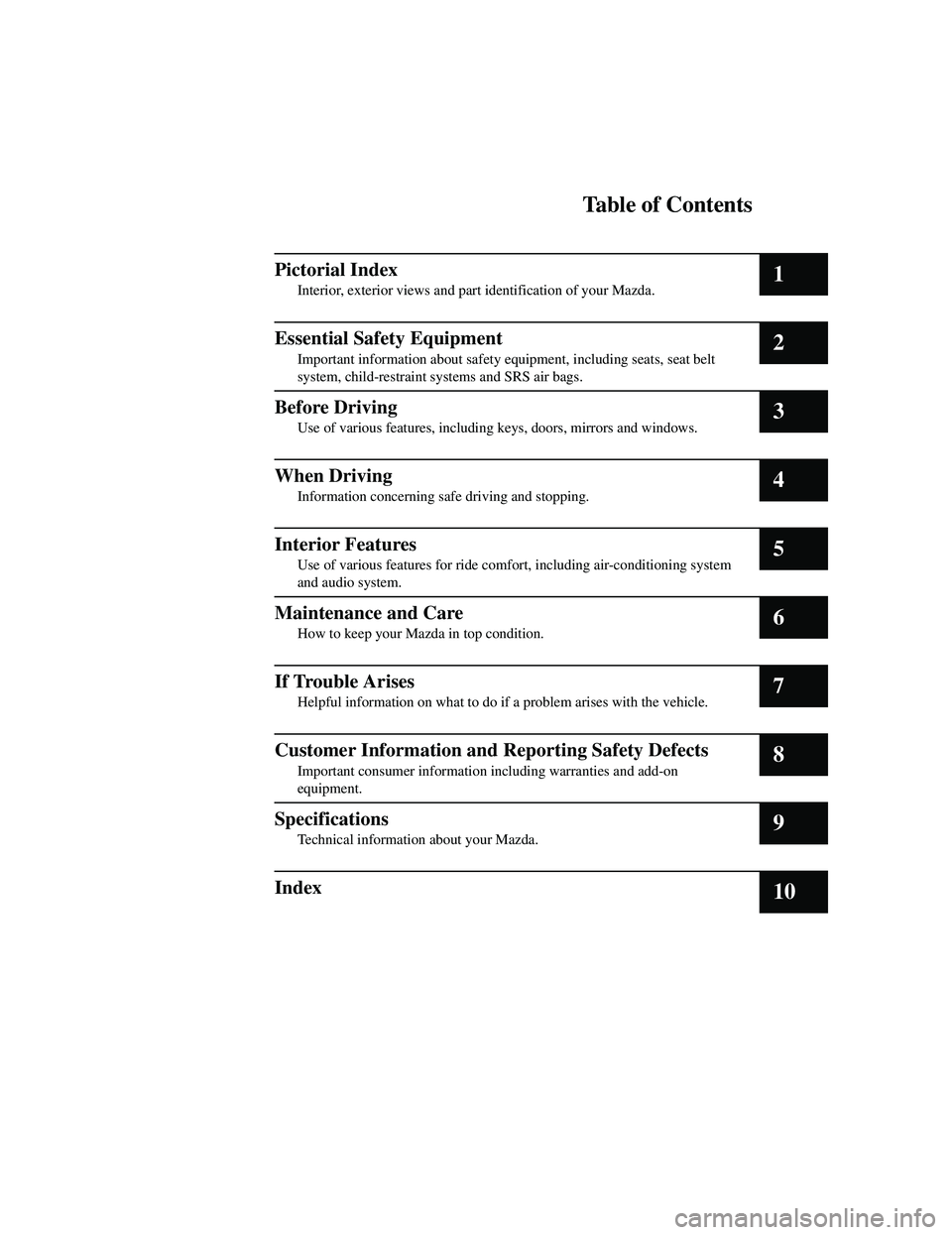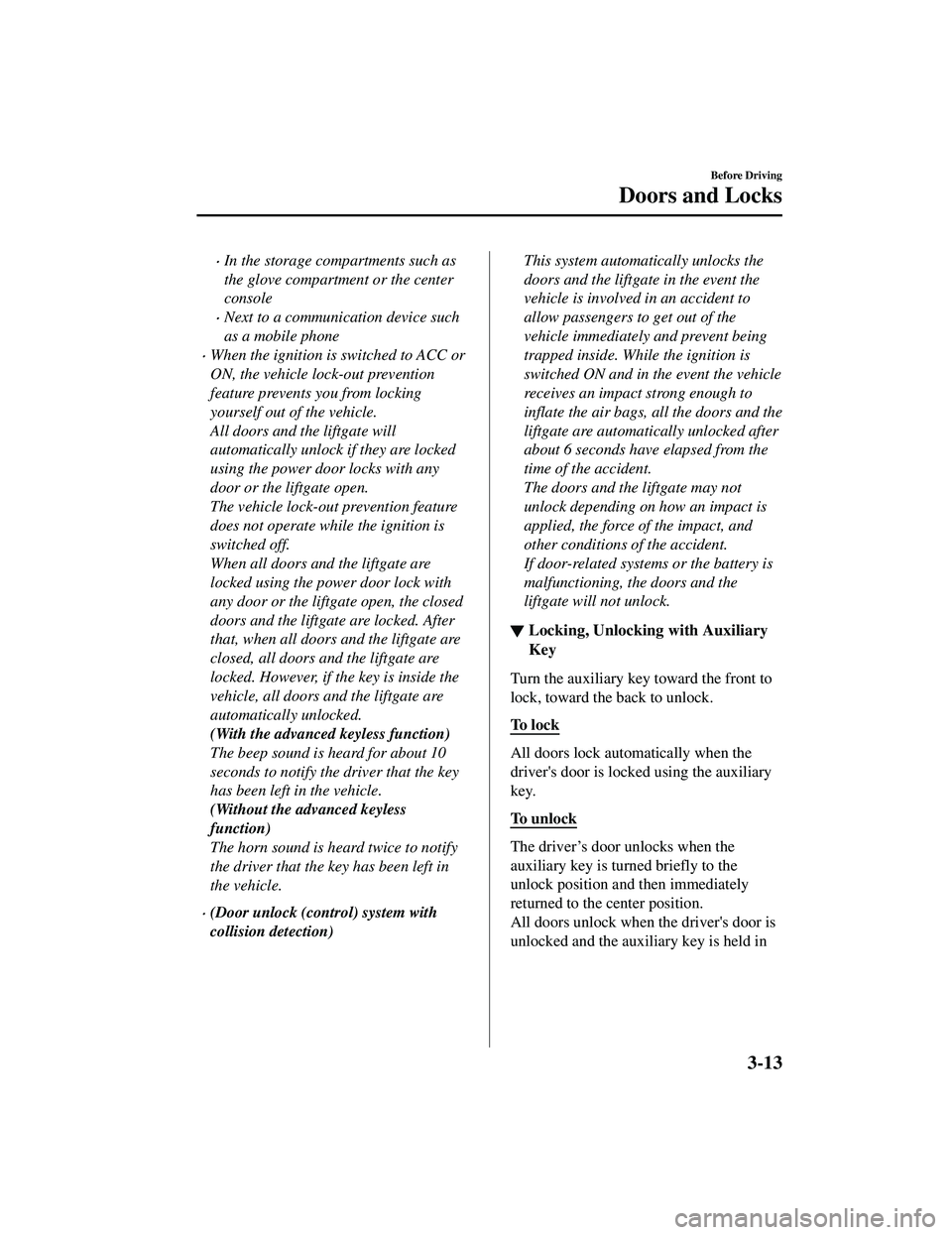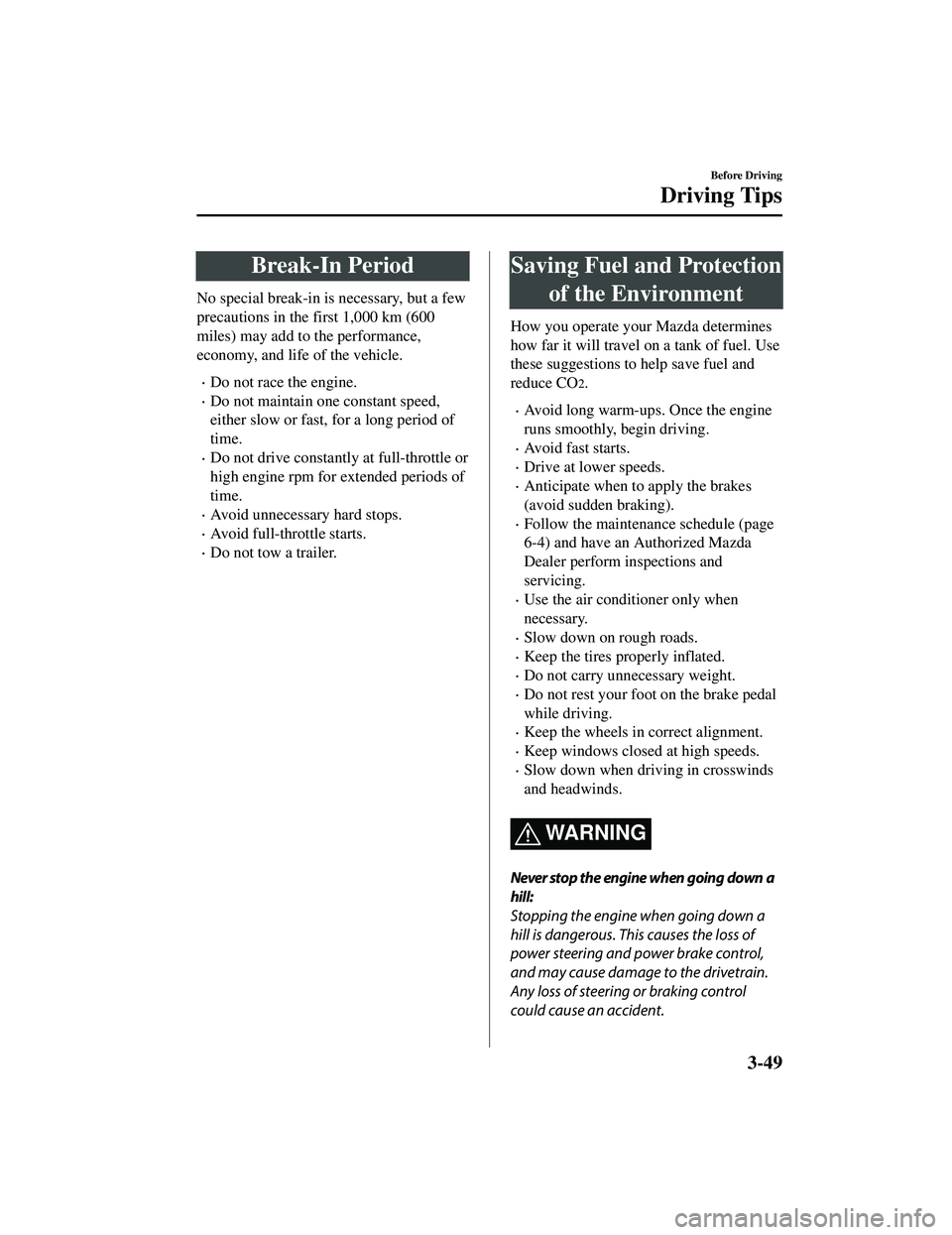air condition MAZDA MODEL CX-9 2021 Owners Manual
[x] Cancel search | Manufacturer: MAZDA, Model Year: 2021, Model line: MODEL CX-9, Model: MAZDA MODEL CX-9 2021Pages: 723, PDF Size: 10.61 MB
Page 4 of 723

Thank you for choosing a Mazda. We at Mazda design and build vehicles with complete
customer satisfaction in mind.
To help ensure enjoyable and trouble-free operation of your Mazda, read this manual
carefully and follow its recommendations.
An Authorized Mazda Dealer knows your vehicle best. So when maintenance or service is
necessary, that's the place to go.
Our nationwide network of Mazda professionals is dedicated to providing you with the best
possible service.
We assure you that all of us at Mazda have an ongoing interest in your motoring pleasure
and in your full satisfaction with your Mazda product.
Mazda Motor Corporation
HIROSHIMA, JAPAN
Important Notes About This Manual
Keep this manual in the gl ove compartment as a handy reference for th e safe and enjoyable use of your Mazda.
Should you resell the vehicle, leave th is manual with it for the next owner.
All specifications and descriptions are accurate at the time of printing. Because impr ovement is a constant goal
at Mazda, we reserve the right to ma ke changes in specifications at any time without notice and without obliga ‐
tion.
Air Conditioner and the Environment
Your Mazda's genuine air conditioner is filled with a refrigerant that has been found not to damage the earth's
ozone layer. If the air conditione r does not operate properly, cons ult an Authorized Mazda Dealer.
Perchlorate
Certain components of this vehicle su ch as [air bag modules, seat belt pretensioners, lithium batteries,…] may
contain Perchlorate Material-- Special handling may a pply for service or vehicle end of life disposal. See
www.dtsc.ca.gov/hazardouswaste/perchlorate.
Please be aware that this manual applies to all mode ls, equipment and options. As a result, you may find
some explanations for equipment not installed on your vehicle.
©2020 Mazda Motor CorporationDecember 2021 (Print6)
A Word to Mazda Owners
CX-9_8JK1-EA-20G_Edition6_old 2021-12-8 9:30:44
Page 6 of 723

Table of Contents
Pictorial Index
Interior, exterior views and part identification of your Mazda.1
Essential Safety Equipment
Important information about safety e quipment, including seats, seat belt
system, child-restraint systems and SRS air bags.2
Before Driving
Use of various features, including keys, doors, mirrors and windows.3
When Driving
Information concerning safe driving and stopping.4
Interior Features
Use of various features for ride co mfort, including air-conditioning system
and audio system.5
Maintenance and Care
How to keep your Mazda in top condition.6
If Trouble Arises
Helpful information on what to do if a problem arises with the vehicle.7
Customer Information and Reporting Safety Defects
Important consumer informati on including warranties and add-on
equipment.8
Specifications
Technical information about your Mazda.9
Index10
CX-9_8JK1-EA-20G_Edition6_old 2021-12-8 9:30:44
Page 53 of 723

Front Seat Belt
Pretensioner and Load Limiting Systems
For optimum protection, the driver and
front passenger seat belts are equipped
with pretensioner and load limiting
systems. For both these systems to work
properly you must wear the seat belt
properly.
Pretensioners:
When a collision is detected, the
pretensioners deploy simultaneously with
the air bags.
For vehicles with the front passenger
occupant classification system, the
pretensioners deploy simultaneously with
the air bags when a roll-over is also
detected.
For deployment details, refer to the SRS
Air Bag Deployment Criteria (page
2-82).
The front seat belt retractors remove slack
quickly as the air bags are expanding. Any
time the air bags and seat belt
pretensioners have fired they must be
replaced.
A system malfunction or operation
conditions are indicated by a warning.
Refer to Taking Action on page 7-37.
Refer to Air Bag/Front Seat Belt
Pretensioner System Warning Beep on
page 7-47.
(With Front Passenger Occupant
Classification System)
In addition, the preten sioner system for the
front passenger, like the front and side
passenger air bag, is designed to only
deploy when the front passenger occupant
classification sensor detects a passenger
sitting on the front passenger's seat.
For details, refer to the front passenger
occupant classification sensor (page
2-85).
Load limiter:
The load limiting system releases belt
webbing in a controlled manner to reduce
belt force on the occupant's chest. While
the most severe load on a seat belt occurs
in frontal collisions, the load limiter has an
automatic mechanical function and can
activate in any accident mode with
sufficient occupant movement.
Even if the pretensioners have not fired,
the load limiting function must be checked
by an Authorized Mazda Dealer.
WA R N I N G
Wear seat belts only as recommended in
this owner's manual:
Incorrect positioning of the driver and front
passenger seat belts is dangerous. Without
proper positioning, the pretensioner and
load limiting systems cannot provide
adequate protection in an accident and
this could result in serious injury. For more
details about wearing seat belts, refer to
"Fastening the seat belts" (page 2-38).
Essential Safety Equipment
Seat Belt Systems
2-40
CX-9_8JK1-EA-20G_Edition6_old 2021-12-8 9:30:44
Page 56 of 723

Do not leave a seat belt extender
connected to the buckle:
Leaving a seat belt extender connected to
the buckle without using the seat belt is
dangerous. When the seat belt extender is
connected to the driver's seat belt buckle
(or front passenger's seat belt buckle), the
SRS driver's (or front passenger's) air bag
system will determine that the driver (or
front passenger) is wearing the seat belt
even if the driver (or front passenger) is not
wearing it. This condition could cause the
driver's (or front passenger's) air bag to not
activate correctly and result in death or
serious injury in the event of collision.
Always wear the seat belt with the seat belt
extender.
Do not use the seat belt extender when
installing a child-restraint system on the
front or rear passenger seat:
Using a seat belt extender to fasten a
child-restraint system on any seat is
dangerous. Always follow the
child-restraint system manufacturer's
installation instructions and never use a
seat belt extender.
NOTE
When not in use, remove the seat belt
extender and store it in the vehicle. If the
seat belt extender is left connected, the
seat belt extender might get damaged as it
will not retract with the rest of the seat belt
and can easily fall out of the door when
not in use and be damaged. In addition,
the seat belt warning light will not
illuminate and function properly.
Essential Safety Equipment
Seat Belt Systems
2-43
CX-9_8JK1-EA-20G_Edition6_old2021-12-8 9:30:44
Page 60 of 723

Seating a child in a child-restraint system on the front passenger seat is dangerous under
certain conditions (With Front Passenger Occupant Classification System):
Your vehicle is equipped with front passenger occupant classification sensor. Even with the
front passenger occupant classification sensor, if you must use the front passenger seat to
seat a child, using a child-restraint system on the front passenger seat under the following
conditions increases the danger of the front passenger air bag deploying and could result in
serious injury or death to the child.
The front passenger air bag deactivation indicator light does not illuminate when seating a
child in the child-restraint system.
Luggage or other items are placed on the seat with the child in the child-restraint system.
A rear passenger or luggage pushing or pulling down on the front passenger seatback.
Luggage or other items are placed on the seatback or hung on the head restraint.
The seat is washed.
Liquids are spilled on the seat.
The front passenger seat is moved backward, pushing into luggage or other items placed
behind it.
The front passenger seatback contacts the rear seat.
Luggage or other items are placed between the front passenger seat and driver seat.
An electric device is put on the front passenger's seat.
An additional electrical device, such as a seat warmer is installed to the surface of the front
passenger seat.
The designated positions with seat belts on the rear seats are the safest places for children.
Always use seat belts and child restraints.
Do not allow a child or anyone to lean over to or against the side window of a vehicle with
side and curtain air bags:
It is dangerous to allow anyone to lean over to or against the side window, the area of the
front passenger seat, the front and rear window pillars and the roof edge along both sides
from which the side and curtain air bags deploy, even if a child-restraint system is used. The
impact of inflation from a side or curtain air bag could ca
use serious injury or death to an out
of position child. Furthermore, leaning over to or against the door could block the side and
curtain air bags and eliminate the advantages of supplemental protection. Because the front
seats are equipped with front air bags, the rear seat is always a better location for children.
Take special care not to allow a child to lean over to or against the side window, even if the
child is seated in a child-restraint system.
Essential Safety Equipment
Child Restraint
2-47
CX-9_8JK1-EA-20G_Edition6_old 2021-12-8 9:30:44
Page 88 of 723

Properly dispose of the air bag system:
Improper disposal of an air bag or a vehicle with live air bags in it can be extremely
dangerous. Unless all safety procedures are followed, injury could result. Have an Authorized
Mazda Dealer safely dispose of the air bag sy stem or scrap an air bag equipped vehicle.
NOTE
If it becomes necessary to have the components or wiring system for the supplementary
restraint system modified to accommodate a person with certain medical conditions in
accordance with a certified physician, contact an Authorized Mazda Dealer, refer to
Page 98 of 723

Front Passenger Occupant Classification System*
First, please read "Supplemental Restraint System (SRS) Precautions" (page 2-69) carefully.
▼Front Passenger Occupant Classification Sensor
Your vehicle is equipped with a front passenger occupant classification sensor as a part of
the supplemental restraint system. This sensor is equipped in the front passenger's seat
cushion. This sensor measures the electrostatic capacity of the front passenger's seat. The
SAS unit is designed to preven
t the front passenger front and side air bags and seat belt
pretensioner system from deploying if the front passenger air bag deactivation indicator
light turns on.
To reduce the chance of injuries caused by deployment of the front passenger air bag, the
system deactivates the front passenger front and side air bags and also the seat belt
pretensioner system when the front passenger air bag deactivation indicator light turns on.
Refer to the following table for the front passenger air bag deactivation indicator light
illumination conditions.
This system shuts off the front passenger front and side air bags and seat belt pretensioner
system, so make sure the front passenger air bag deactivation indicator light turns on
according to the following table.
The air bag/front seat belt pretensioner system warning light flashes and the front passenger
air bag deactivation indicator light illuminates if the sensors have a possible malfunction. If
this happens, the front passenger front and side air bags and seat belt pretensioner system
will not deploy.
Front passenger air bag deactivation indicator light
This indicator light turns on to remind you that the front passenger front and side air bags
and seat belt pretensioner will not deploy during a collision.
Essential Safety Equipment
SRS Air Bags
*Some models.2-85
CX-9_8JK1-EA-20G_Edition6_old 2021-12-8 9:30:44
Page 99 of 723

If the front passenger occupant classification sensor is normal, the indicator light turns on
when the ignition is switch ed ON. The light turns off af ter a few seconds. Then, the
indicator light turns on or is off under the following conditions:
Front passenger air bag deactivation i ndicator light on/off condition chart
Condition detected by the front
passenger occupant classifica ‐
tion system Front passenger air
bag deactivation indi ‐
cator light Front passenger front
and side air bags Front passenger seat
belt pretensioner sys ‐
tem
Empty (Not occupied) OnDeactivated Deactivated
A child less than 1 year old is
seated in a child-restraint system On
Deactivated Deactivated
Child
*1On or off Deactivated or ready Deactivated or ready
Adult
*2Off Ready Ready
*1 The occupant classification sensor may not detect a child seated on the seat, in a child-restraint system, or a
junior seat depending on the child's physical size and seated posture.
*2 If a smaller adult sits on the front passenger seat, the sensors might detect the person as being a childdepending on the person's physique.
The curtain air bag is ready for inflating re gardless of what the front passenger air bag
deactivation indicator light on/off condition chart indicates.
If the front passenger air bag deactivation indicat or light does not turn on when the ignition
is switched ON and does not turn on as indi cated in the front passenger air bag deactivation
indicator light on/off condition chart, do not allow an occupant to sit in the front passenger
seat and consult an Authorized Mazda Dealer as soon as possible. The system may not work
properly in an accident.
WA R N I N G
Do not allow an occupant in the front passenger's seat to sit with a posture which makes it
difficult for the front passenger occupant
classification sensor to detect the occupant
correctly:
Sitting in the front passenger's seat with a posture which makes it difficult for the front
passenger occupant classification sensor to dete ct the occupant correctly is dangerous. If the
front passenger occupant classification sensor ca nnot detect the occupant sitting on the front
passenger's seat correctly, the front passenge r front and side air bags and pretensioner
system may not operate (non-deploy) or they may operate (deploy) accidentally. The front
passenger will not have the su pplementary protection of the air bags or the accidental
operation (deployment) of the air bags co uld result in serious injury or death.
Under the following conditions, the front passe nger occupant classification sensor cannot
detect a passenger sitting on the front passe nger's seat correctly and the deployment/
non-deployment of the air bags cannot be contro lled as indicated in the front passenger air
bag deactivation indicator light on /off condition chart. For example:
Essential Safety Equipment
SRS Air Bags
2-86
CX-9_8JK1-EA-20G_Edition6_old 2021-12-8 9:30:44
Page 116 of 723

In the storage compartments such as
the glove compartment or the center
console
Next to a communication device such
as a mobile phone
When the ignition is switched to ACC or
ON, the vehicle lock-out prevention
feature prevents you from locking
yourself out of the vehicle.
All doors and the liftgate will
automatically unlock if they are locked
using the power door locks with any
door or the liftgate open.
The vehicle lock-out prevention feature
does not operate while the ignition is
switched off.
When all doors and the liftgate are
locked using the power door lock with
any door or the liftgate open, the closed
doors and the liftgate are locked. After
that, when all doors and the liftgate are
closed, all doors and the liftgate are
locked. However, if the key is inside the
vehicle, all doors and the liftgate are
automatically unlocked.
(With the advanced keyless function)
The beep sound is heard for about 10
seconds to notify the driver that the key
has been left in the vehicle.
(Without the advanced keyless
function)
The horn sound is heard twice to notify
the driver that the key has been left in
the vehicle.
(Door unlock (control) system with
collision detection)
This system automatically unlocks the
doors and the liftgate in the event the
vehicle is involved in an accident to
allow passengers to get out of the
vehicle immediatel y and prevent being
trapped inside. While the ignition is
switched ON and in the event the vehicle
receives an impact strong enough to
inflate the air bags, all the doors and the
liftgate are automatically unlocked after
about 6 seconds have elapsed from the
time of the accident.
The doors and the liftgate may not
unlock depending on how an impact is
applied, the force of the impact, and
other conditions of the accident.
If door-related systems or the battery is
malfunctioning, the doors and the
liftgate will not unlock.
▼ Locking, Unlocking with Auxiliary
Key
Turn the auxiliary key toward the front to
lock, toward the back to unlock.
To l o c k
All doors lock automatically when the
driver's door is locked using the auxiliary
key.
To unlock
The driver’s door unlocks when the
auxiliary key is turned briefly to the
unlock position and then immediately
returned to the center position.
All doors unlock when the driver's door is
unlocked and the auxiliary key is held in
Before Driving
Doors and Locks
3-13
CX-9_8JK1-EA-20G_Edition6_old
2021-12-8 9:30:44
Page 152 of 723

Break-In Period
No special break-in is necessary, but a few
precautions in the first 1,000 km (600
miles) may add to the performance,
economy, and life of the vehicle.
Do not race the engine.
Do not maintain one constant speed,
either slow or fast, for a long period of
time.
Do not drive constantly at full-throttle or
high engine rpm for extended periods of
time.
Avoid unnecessary hard stops.
Avoid full-throttle starts.
Do not tow a trailer.
Saving Fuel and Protectionof the Environment
How you operate your Mazda determines
how far it will travel on a tank of fuel. Use
these suggestions to help save fuel and
reduce CO
2.
Avoid long warm-ups. Once the engine
runs smoothly, begin driving.
Avoid fast starts.
Drive at lower speeds.
Anticipate when to apply the brakes
(avoid sudden braking).
Follow the maintenance schedule (page
6-4) and have an Authorized Mazda
Dealer perform inspections and
servicing.
Use the air conditioner only when
necessary.
Slow down on rough roads.
Keep the tires properly inflated.
Do not carry unnecessary weight.
Do not rest your foot on the brake pedal
while driving.
Keep the wheels in correct alignment.
Keep windows closed at high speeds.
Slow down when driving in crosswinds
and headwinds.
WA R N I N G
Never stop the engine when going down a
hill:
Stopping the engine when going down a
hill is dangerous. This causes the loss of
power steering and power brake control,
and may cause damage to the drivetrain.
Any loss of steering or braking control
could cause an accident.
Before Driving
Driving Tips
3-49
CX-9_8JK1-EA-20G_Edition6_old 2021-12-8 9:30:44